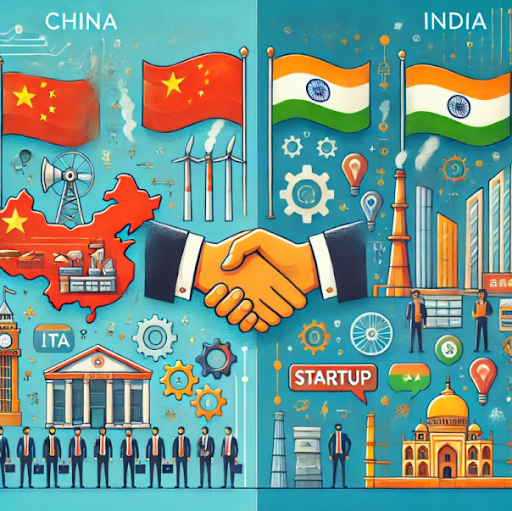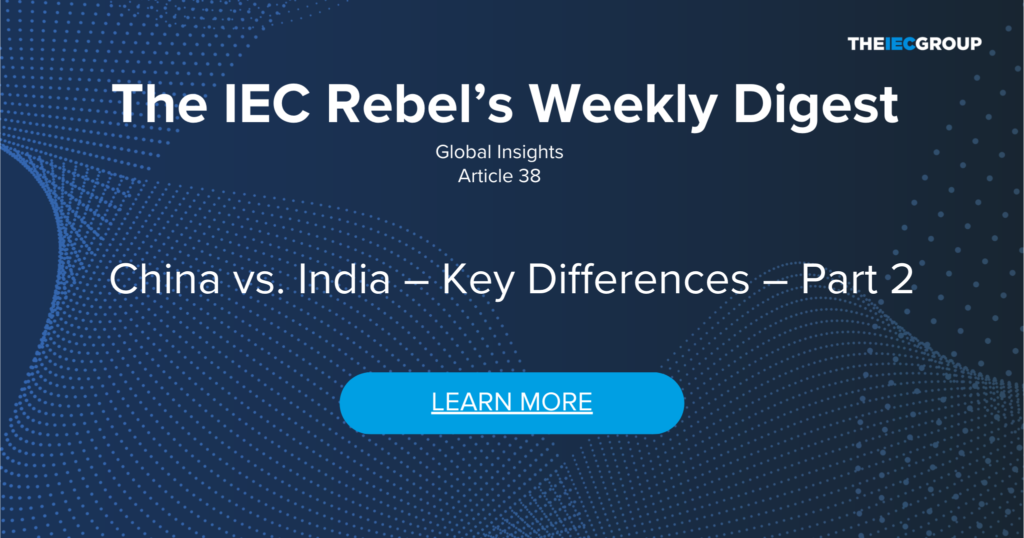China vs. India – Key Differences in Starting a Business – Executive Summary
 Starting a business in China and India, the two most populous nations, offers unique challenges and vast opportunities. China, with its streamlined processes, provides quicker entry but demands navigation through a controlled regulatory environment, particularly in sensitive sectors. India, while improving, involves more complex procedures, reflecting its decentralized and diverse regulatory landscape.
Starting a business in China and India, the two most populous nations, offers unique challenges and vast opportunities. China, with its streamlined processes, provides quicker entry but demands navigation through a controlled regulatory environment, particularly in sensitive sectors. India, while improving, involves more complex procedures, reflecting its decentralized and diverse regulatory landscape.
China excels in manufacturing and technology, fueled by strong government support, while India thrives in IT services and pharmaceuticals, driven by its youthful population. Cultural adaptability is crucial—China’s business environment values relationships (guanxi), while India’s market requires understanding regional diversity.
Both countries offer immense potential, but success hinges on tailored strategies that align with each nation’s distinct economic and cultural contexts.
China vs. India – Key Differences in Starting a Business
Starting a business in India and China presents different sets of challenges and opportunities, influenced by each country’s regulatory environment, economic policies, and market dynamics. Below is a comparison based on several key factors:
- Ease of Starting a Business
- China:
- Ranking: China ranks moderately well in terms of ease of doing business, particularly after significant reforms in recent years aimed at reducing red tape and improving the business climate. According to the World Bank’s Ease of Doing Business report, China is ranked around 31st globally (based on the last available report from 2020).
- Procedures: Starting a business in China typically involves fewer procedures than in India, such as registering the company name, obtaining a business license, and registering for taxes, which can generally be completed in a few weeks.
- Challenges: However, foreign businesses may face additional hurdles such as language barriers, cultural differences, and navigating local regulations, especially in sectors deemed sensitive or strategically important by the Chinese government.
- India:
- Ranking: India has made substantial improvements in recent years, moving up in global rankings to around 63rd in the World Bank’s Ease of Doing Business index (as of the last available report). The government has introduced reforms to simplify the process of starting a business, such as reducing the number of procedures and improving online services.
- Procedures: In India, starting a business can still involve multiple steps, including registering with the Ministry of Corporate Affairs, obtaining a Director Identification Number (DIN), securing a Digital Signature Certificate (DSC), and registering for taxes. The entire process may take longer compared to China, often several weeks to a few months.
- Challenges: Bureaucracy, slower approval processes, and complex regulatory requirements can still be obstacles, although the situation has been improving.
- Regulatory Environment
- China:
- Regulations: China’s regulatory environment is relatively structured but can be stringent, particularly for foreign enterprises. Certain industries are highly regulated, with some sectors being restricted or prohibited for foreign investment.
- Government Influence: The Chinese government has significant influence over business operations, especially in strategic sectors. There is also a focus on compliance with local standards, and regulations can change rapidly, requiring businesses to adapt quickly.
- Intellectual Property: While China has improved its intellectual property (IP) laws, enforcement remains inconsistent, which can be a concern for businesses relying on proprietary technology or brand protection.
- India:
- Regulations: India’s regulatory environment is complex and varies by state. While the central government has implemented reforms to simplify business procedures, navigating the regulatory landscape can still be challenging, especially for smaller enterprises.
- Government Influence: India’s regulatory framework is more decentralized, with significant variation in the ease of doing business between different states. However, this can also lead to inconsistencies in policy implementation.
- Intellectual Property: India has a robust legal framework for intellectual property protection, but enforcement can be slow and sometimes inefficient.
- Market Potential
- China:
- Market Size: China’s large population and rapidly growing middle class provide a vast market for consumer goods, technology, and services. The country is also a manufacturing hub, offering opportunities in various industrial sectors.
- Consumer Preferences: China has a well-developed e-commerce ecosystem, with consumers increasingly tech-savvy and open to new products. However, market entry can be difficult due to strong competition and the need to localize products for Chinese tastes.
- India:
- Market Size: India’s large and youthful population represents a significant market potential, especially as income levels rise and urbanization increases. There is substantial demand for consumer goods, technology, healthcare, and financial services.
- Consumer Preferences: The Indian market is diverse and price-sensitive. Successful businesses often tailor their offerings to meet the specific needs of different regions and income groups. E-commerce is growing rapidly, driven by increased internet penetration.
- Access to Finance
- China:
- Financing Options: China has a well-developed financial sector, with access to capital through both state-owned and private banks, venture capital, and equity markets. However, foreign companies may find it more challenging to secure financing compared to local firms.
- Government Support: The Chinese government provides substantial support for key industries, particularly in technology, infrastructure, and green energy, offering various incentives and subsidies.
- India:
- Financing Options: India’s financial sector is growing, with increasing access to venture capital, angel investors, and government-backed funding schemes, especially for startups. However, small and medium enterprises (SMEs) may still find it challenging to secure financing from traditional banks.
- Government Support: The Indian government has launched several initiatives to support entrepreneurship, including the Startup India campaign, which offers tax benefits, simplified regulations, and easier access to funding for startups.
- Cultural and Business Practices
- China:
- Business Culture: Building relationships (guanxi) is critical in China, and networking with local partners and officials is often essential for business success. Decision-making can be hierarchical, and negotiations may take longer.
- Language: While English is becoming more common in business circles, Mandarin is the primary language, and fluency can be a significant advantage.
- India:
- Business Culture: India’s business culture is diverse, with significant variations between regions. Building relationships and trust is important, and negotiations may involve extensive discussions and consensus-building.
- Language: English is widely spoken in business settings, which can make it easier for foreign companies to operate. However, knowledge of local languages can be beneficial in certain regions.
Comparison Summary:
- China: Easier to start a business in terms of speed and fewer procedures, but with a more challenging regulatory environment for foreign businesses, especially in sensitive sectors. The market is highly competitive, and there is significant government involvement in business operations.
- India: Starting a business may take longer due to more complex regulatory requirements, but the environment is improving with recent reforms. India offers significant market potential with a younger population and growing consumer base, though the market is diverse and price-sensitive.
Conclusion: Both countries offer vast opportunities but come with unique challenges. China might be more favorable for companies looking to scale quickly in a structured environment, while India presents opportunities for businesses willing to navigate a more complex and decentralized system with a high-growth potential market.
Go To’s: Develop tailored strategies, prioritize local partnerships, and adapt to each market’s unique regulatory and cultural landscape. And don’t forget to look at all other aspects as well.
Introducing the IEC Knowledge Network Free Membership – Your Gateway to Seamless Access!
We are thrilled to present a new service that goes beyond the ordinary download experience. In addition to offering you the ability to download the things you love, we are delighted to introduce the IEC Knowledge Network Free Membership.
The Free Membership option grants you access to our library of articles and videos, without the need for tedious registrations for each piece of content.
The publication serves as a trusted resource to support executives in their pursuit of sustainable and successful global expansion. In addition the IEC Practitioners are available to discuss your specific challenge in more detail and to give you clear advise..
Take advantage of this valuable resource to accelerate your global expansion journey


